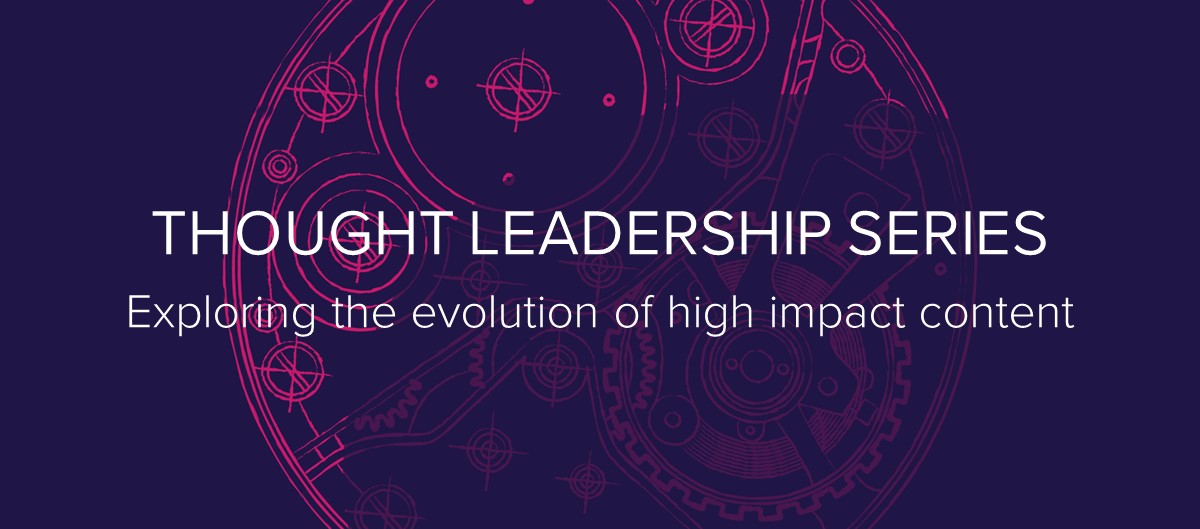Delivering high-impact thought leadership: Lessons from a Big Four approach
April 20, 2020 • 5 minute read

In the first of a series of posts on how professional services firms can be smart about how they create content that builds brand and powerfully connects with audiences, Infinite Global’s Jamie Obertelli spoke to Lewis Woodward, former Partner and Global Communications and Engagement Leader at EY.
As the Big Four have transformed their business models over the years, evolving from providing accountancy and audit services to become broad-based global business advisory consultants, thought leadership has played a central part in presenting them as go-to experts in a range of areas.
Outside of what has traditionally been seen as their core business, Big Four firms are tackling topics from digital disruption, innovation and growth, to employment and labor issues and analysis of the world of sport, to name a few. Other professional services firms, from law firms to real estate consultants, have been following suit. But what are the keys to success and what can be learned from their approach?
To hear the story of one firm’s approach, we spoke with Lewis Woodward, whose experience in comms and marketing spans two decades. During that time he has been involved in many different multichannel thought leadership programs, most recently at EY where he led the communications and engagement function.
Thought leadership as reputational driver
The space in which the Big Four operate is a dynamic marketplace that continues to be shaped by shifting demands and pressures, not least regulatory changes and media scrutiny. Woodward sees the role of thought leadership in corporate environments like those of the Big Four as “really focused on reputation.” Rather than being about sales acquisition and how marketing programs can drive customer value, his view is that the emphasis is on “how we protect brands and build a reputation through clever, clear, concise communications, both internally and externally.”
However, shaping the narrative is not easy when there are so many different stakeholders. When it comes to audit and assurance, there are audit committees within corporates, investors, regulators and employees as well as the wider public to reach out to and with whom to maintain good relations. Keeping messaging and look and feel consistent across all geographies can also be challenging for global organizations.
“Mapping out all the various audiences is very complex,” says Woodward. “You need to come out with a narrative that is distinctive to the competition. In a marketplace which is potentially quite monopolized, it’s very difficult to stand out.”
Delivering distinctiveness
Woodward points to the dichotomy at the heart of how the Big Four (and many other professional services firms) engage in thought leadership. On the one hand, this is a very traditional and corporate business sector, which must ensure technical accuracy in all its outputs. On the other, in order for thought leadership programs to be successful, they must be innovative in their content and essentially take a consumer-oriented approach in the way it is produced and presented. Brands need to communicate in a way that chimes with how people consume content in the marketplace – and today that’s very different to how corporate comms has developed in the past.
In Woodward’s opinion, questions professional firms need to be asking include: “Is it creative? Is it engaging? Is it multichannel? Is it data-driven? Does it portray the feeling that the firm is in control of its own destiny? And is it a thought leader in the truest sense, not a follower of what other firms are doing?”
Broadening the brand
When developing a content plan, Woodward advises firms to think about what will broaden their brand consideration. Firms may be known for a particular area, like audit, but people may not know they are involved in digital services or in helping solve some of the world’s biggest health or social issues, for example. Talking about the less well-known aspects of the business or unexpected topics, and doing so in imaginative ways (such as via podcasts, video and interactive events as well as written content) can help start conversations, and demonstrate how diverse and forward-thinking you are as an organization. As people within the business, from the C-Suite down, recognize that impetus, ideas can blossom.
What’s the follow-through?
Woodward warns that the commercial payback for the investment in developing a thought leadership program can sometimes be forgotten and stresses the importance of linking content strongly back to the organization. Relevance to the business, ownership of the topic and engagement with the relevant audiences are all key and should translate into positive outcomes for the brand. Furthermore, all those within the business must understand and buy into it if they are to amplify it for maximum effect via their own social media and other communications channels.
Thought leadership may come under the banner of comms and business development, but ultimately, making sure it’s as powerful as possible is a firm-wide effort. The call to action matters – both internally and externally.
Need help creating unique, targeted engaging thought leadership? Infinite Global can help you develop a bespoke strategy to suit the needs of your firm, empower your stakeholders and connect with your audience.
